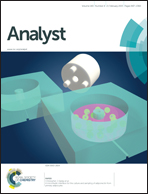A uniform 2,5-dihydroxybenzoic acid layer as a matrix for MALDI-FTICR MS-based lipidomics
Abstract
A very uniform 2,5-dihydroxybenzoic acid (DHB) layer was for the first time constructed and used as a matrix for matrix-assisted laser desorption ionization Fourier transform ion cyclotron resonance mass spectrometry (MALDI-FTICR MS) for quickly exploring the changes in lipids within biological systems. Lipid extracts from biological samples were dissolved in chloroform and deposited onto the DHB layer. Benefiting from the insolubility of DHB in chloroform, the uniform matrix crystals were still maintained, and more importantly, the lipid analytes were distributed homogeneously on the layer, which significantly increased the reproducibility of analysis using MALDI-FTICR MS. Taking advantage of the benefit of high resolution of FTICR MS and the fragment ions obtained by MS/MS, lots of lipids were identified. This method was used for exploring the changes of lipids in drug-resistant tumor cells compared with paired drug-sensitive tumor cells. The principal component analysis (PCA) and partial least-squares discriminant analysis (PLS-DA) were employed for discovery of the changed lipids. This method, characterized by the simplicity and the speediness, demonstrated a new and promising approach for lipidomics study.


 Please wait while we load your content...
Please wait while we load your content...